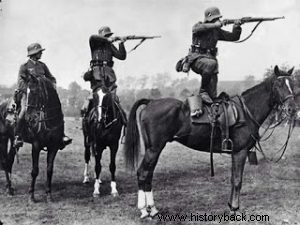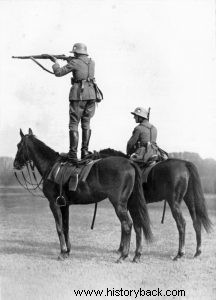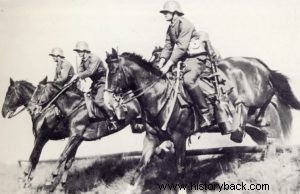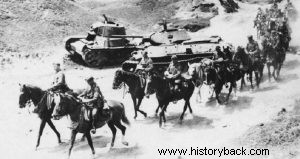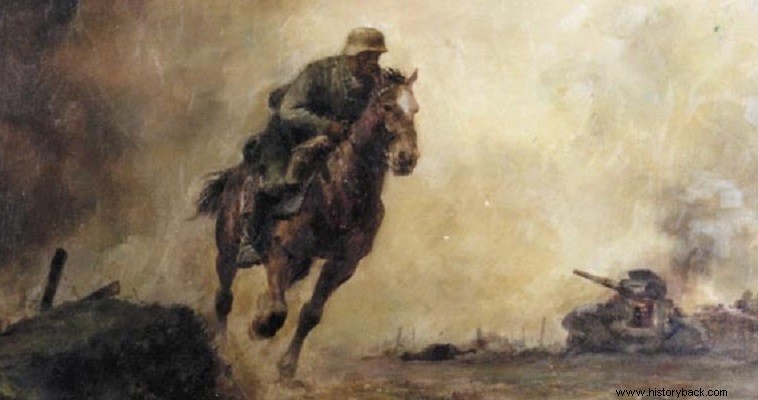
In February 1942 the 1st Cavalry Division (MI) of the German army was disbanded. However, its dissolution did not mean the end of cavalry in the German Army. Cavalry islands and reconnaissance regiments continued to exist and provide excellent service for their respective formations, often clashing with Soviet cavalry.
Although there was no cavalry formation, nevertheless, on the Eastern Front, in the winter of 1941-42, dozens of cavalry islands were serving, mainly in the reconnaissance groups of infantry divisions.
The Waffen SS they had also formed units and later cavalry divisions, which fought until almost the end of World War II. In the meantime the cavalry units of the army continued to serve with tremendous success, especially in the midst of the horrible Russian winter, as where foot and motorized vehicles could not move, horses could.
Of course the mortality of the sympathetic animals was high, but the Germans were able to replenish the losses, using horses mastered by the Soviets, which also had excellent resistance to weather conditions. They were the famous Panje horses, which were descended from the Polish Konik breed .
The Germans quickly learned the lesson of the Soviets and their mounted units used horses exclusively to carry heavy weapons and supplies. The biggest problem, however, was not the snow, but the mud.
Cavalry formations
The good services of the cavalry gave rise to various considerations, such as the reorganization of cavalry bands and formations. The main reason was his tactical agility and flexibility in an even more difficult fight, that of the pursuit of the partisans. Thousands of partisans operated behind German lines, hiding mainly in the forests of Belarus and in the Pripet marshes area.
This fight was undertaken by detachments of cavalry. These detachments usually started as soon as night fell and after reaching the control area they deployed and ambushed there, hitting partisan units by surprise. This tactic proved to be highly successful and was the reason why the Germans decided to form cavalry divisions with Soviet nationals to use in the anti-partisan fight which was wild and "dirty".
It is worth noting that this tactic was copied by the 'Ironmen', the South African police special forces unit that fought in the 1980s in Namibia. The clashes with the partisans, however, were particularly fierce with both sides rarely showing mercy towards their opponents.
In the spring of 1942 there were about 25 mounted reconnaissance groups who operated on the Eastern Front. OKI then decided to reorganize the weapon, forming a cavalry force, which would form a flexible reserve force in the hands of the command.
However, the general at the time, Walter Modell, having first-hand experience of the value of cavalry from the Kiev operations, decided first to form a cavalry force from the gun divisions that existed in the 9th Army he commanded. Thus the Kavallerie Kommando zbV was formed .
The unit, at regimental level, was made up of the reconnaissance divisions of the XXII and XXVII Army Corps (SS), reinforced by platoons of mounted infantry. The unit was developed into a brigade eventually lining up the 1st, 2nd and 3rd Cavalry Regiments (SI), with the addition of reconnaissance divisions of the 6th and 26th Infantry Divisions (MP).
However, this unit was short-lived. He successfully fought in the forests around Rzhev during Operation Seydlitz (July 2-23, 1942), when Model's 9th Army annihilated the Soviet 39th Army and 11th Cavalry Corps. The German cavalry fought well, but for inexplicable reasons, it was decided to disband the unit and the units that made it up returned to their familiar formations.
A little later, in late 1942, early 1943, another regimental level unit was formed, known by the name of its commander, Major von Besselager . With the support of Army Group (OS) "Center" commander Field Marshal von Kluge, the regiment was endowed with six islands, five German and one Cossack. The six islands, two each, formed a prefecture. The provinces usually acted autonomously.
The regiment was later named Centre Cavalry Regiment . The example of OS "Center" was soon followed by OS "North" and "South" where, respectively, the eponymous cavalry regiments were formed, one under Prince Karl of Zalm-Hordmar and the other under Prince Zein-Wittgenstein, both nobles and old cavalry officers.
These regiments were equipped with the new MP43 and Sturmgewehr 44 assault rifles. and the corresponding group weapons. The regiments had a strength of 1,100 men each. However they gradually evolved into brigade level units fielding 6,200 men, with 5,967 horse power, 308 carriages, eight wheeled armored reconnaissance vehicles, 115 motorcycles, and 237 cars of all types. The brigade was equipped with 188 light machine guns, 42 machine guns, 495 sub-machine guns, 36 mortars, three 75mm anti-aircraft guns, RAK 40, 12 105mm guns and 12 20mm A/A guns.
The brigade fielded three mounted regiments, each with three combat regiments and a heavy regiment which was motorized and had a motorcycle ulama, an armored vehicle ulama, and an anti-tank ulama. It also had an artillery squadron with three artillery companies of four 105mm guns each.
This squadron also included the artillery of the A/A. The brigade also had a transport company, partly motorized, an engineer company, a transport battalion, partly motorized, sanitary, veterinary and repair sections. The paradox is that as the war drew to a close, the German The army was also forming new cavalry units.
1st Cavalry Corps
In the summer of 1944, the 3rd and 4th Cavalry Brigades (TI) were formed from the "Center", "North" and "South" cavalry forces, while the "North" SI was renamed the 5th SI and the "South" SI was renamed the 41st Cavalry Corps (SI). In July 1944 the two TIs together with the Hungarian 1st Cavalry Division (MI), formed the Army Cavalry Corps (SSI) Hartenek – later 1st SSI.
During the major Soviet offensive in Belorussia (Operation Bagration) the 1st SSI acted heroically, acting as a rear guard, covering retreating German infantry, sometimes acting in conjunction with armored formations. Not being pleased with the performance of the Hungarians, Hartenek demanded and succeeded in removing them from the corps' order of battle.
The action of the 1st SSI was instrumental in stabilizing the front, in the autumn of 1944, in the sector of the Narew and Bug rivers, in Poland. The 1st SSI also fought brilliantly in Poland and then, in December 1944, was sent to Hungary. At that time the 1st SSI fielded about 14,000 men. The commander of the 1st SSI, General Gustav Hartenek he later wrote:"As the 1st SSI was ordered to deploy defensively, much to our dismay.
"SS MIs were fighting in Budapest. We all knew nothing good was going to come of this. The SS had been surrounded. The 1st SSI carried out a night attack in order to relieve the besieged. Although we managed to reach the outskirts of the city, only 100 of the besieged horsemen managed to take advantage of our attack and break the cordon.
For others it was too late. The Russians were very powerful. In this particular battle, the 1st SSI was operationally under the 6th SS Army. Perhaps, however, the whole evolution of the battle would have been different if, instead of the administration trapping the two SS MIs in the city, it had used them in the battle as what they were, cavalry".
The Battle of Budapest ended on February 13 with the capture of the city by the Soviets. But the 1st SSI had fought so well that OKI decided to deploy the two TIs to MI, with the same numbers, 3rd and 4th. However, the deployment was theoretical as each MI had only two SIs, an artillery regiment, an anti-tank squadron, a transport battalion, a field battalion and an engineer company.
With its new composition, as far as it could go, the 1st Division retreated fighting into Austria and from there into Italy, succeeding in surrendering to the British 8th Army on 10 May 1945. At the time of its surrender, the 1st Division had 22,000 men and 16,000 horsepower. The horses were made available to the farmers there while the men of the corps were transferred to Hesse and Württemberg and gradually liberated. General Hartenek was held in captivity until 1947 when he was released. This was also the end of the German cavalry.
